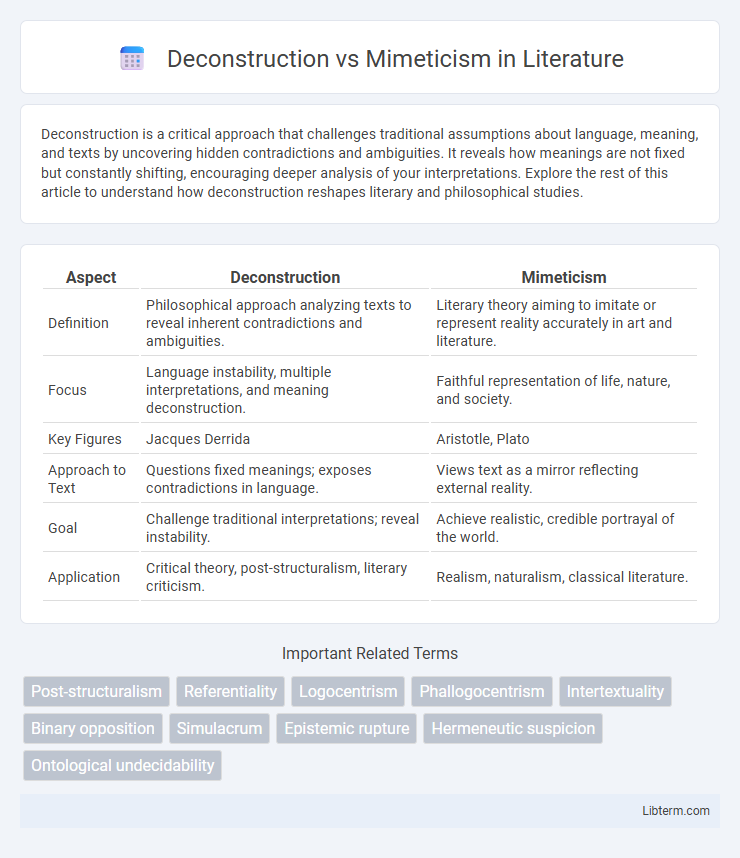Deconstruction is a critical approach that challenges traditional assumptions about language, meaning, and texts by uncovering hidden contradictions and ambiguities. It reveals how meanings are not fixed but constantly shifting, encouraging deeper analysis of your interpretations. Explore the rest of this article to understand how deconstruction reshapes literary and philosophical studies.
Table of Comparison
| Aspect | Deconstruction | Mimeticism |
|---|---|---|
| Definition | Philosophical approach analyzing texts to reveal inherent contradictions and ambiguities. | Literary theory aiming to imitate or represent reality accurately in art and literature. |
| Focus | Language instability, multiple interpretations, and meaning deconstruction. | Faithful representation of life, nature, and society. |
| Key Figures | Jacques Derrida | Aristotle, Plato |
| Approach to Text | Questions fixed meanings; exposes contradictions in language. | Views text as a mirror reflecting external reality. |
| Goal | Challenge traditional interpretations; reveal instability. | Achieve realistic, credible portrayal of the world. |
| Application | Critical theory, post-structuralism, literary criticism. | Realism, naturalism, classical literature. |
Introduction to Deconstruction and Mimeticism
Deconstruction, rooted in Derrida's philosophy, challenges traditional structures by exposing inherent contradictions and ambiguities within texts, undermining fixed meanings. Mimeticism emphasizes faithful representation, aiming to mirror reality or nature accurately through art and literature, often prioritizing imitation and replication. These opposing approaches define critical debates on interpretation, authenticity, and the role of language in conveying truth.
Historical Origins of Deconstruction
Deconstruction originated in the late 1960s with philosopher Jacques Derrida, whose work challenged traditional assumptions about language, meaning, and text interpretation in Western philosophy. Grounded in structuralism and post-structuralism, deconstruction critiques binary oppositions and hierarchical structures inherent in texts, emphasizing the instability of meaning. This intellectual movement diverged sharply from mimeticism, which centers on realistic representation and imitation of reality in art and literature.
Roots and Evolution of Mimeticism
Mimeticism traces its roots to ancient Greek philosophy, where thinkers like Aristotle emphasized imitation as a fundamental aspect of art and human cognition, reflecting reality to evoke emotional catharsis. Over centuries, Mimeticism evolved through classical and Renaissance art, reinforcing the idea that artistic representation should mirror the external world to convey truth and beauty. This evolution contrasts sharply with Deconstruction, which challenges fixed meanings and critiques the assumptions underlying mimetic representation.
Core Philosophical Differences
Deconstruction challenges the idea of fixed meanings by exposing inherent contradictions and ambiguities within texts, emphasizing the instability of language and meaning. Mimeticism centers on the faithful representation or imitation of reality, asserting that art or literature should closely mirror the external world. The core philosophical difference lies in deconstruction's focus on the fluidity and multiplicity of interpretations versus mimeticism's commitment to objective replication of reality.
Language, Representation, and Meaning
Deconstruction challenges traditional notions of language by exposing the inherent instability and multiplicity of meanings in texts, undermining fixed representations and questioning the possibility of a singular, definitive interpretation. Mimeticism emphasizes language as a transparent medium that mirrors reality faithfully, advocating for representation to accurately reflect the external world and preserve stable meaning. The tension between these approaches centers on whether language reveals objective truths or constructs fluid, context-dependent meanings that resist definitive representation.
Deconstruction’s Critique of Mimesis
Deconstruction challenges mimeticism by questioning the assumption that art merely imitates reality, exposing the instability of meaning and representation inherent in this perspective. It reveals how mimesis relies on binaries such as reality/representation and presence/absence, which are deconstruction's prime targets for destabilization. By undermining these binaries, deconstruction critiques mimesis as an oversimplified framework that ignores the complexities of language, interpretation, and the constructed nature of meaning in art.
Mimeticism: Art as Imitation
Mimeticism, rooted in classical philosophy, defines art as imitation of reality, aiming to replicate the external world with accuracy and fidelity. This approach emphasizes representational techniques, striving to capture lifelike details, emotions, and naturalistic forms that mirror human experience. By focusing on imitation, Mimeticism upholds the connection between art and observable phenomena, reinforcing the traditional view of art's purpose as reflecting the tangible environment.
Key Thinkers: Derrida vs. Aristotle
Jacques Derrida's deconstruction challenges Aristotle's mimeticism by questioning the fixed meanings and inherent truths in texts, emphasizing the fluidity of language and interpretation. Aristotle's mimeticism asserts art as an imitation of reality, grounded in representation and objective truth, which contrasts Derrida's focus on the instability of meaning. Derrida's critical approach disrupts traditional notions of representation championed by Aristotle, reshaping contemporary literary and philosophical theory.
Applications in Literary and Art Criticism
Deconstruction challenges traditional literary and art criticism by dissecting language, revealing inherent ambiguities and contradictions that question fixed meanings and authorial intent. Mimeticism, rooted in classical theory, emphasizes the faithful representation of reality or nature, guiding critics to evaluate works based on their accuracy and fidelity to observable life. In contemporary criticism, deconstruction offers tools for exploring multiple interpretations, while mimeticism remains influential in assessing the authenticity and cultural reflection within artistic and literary creations.
Contemporary Relevance and Debates
Deconstruction challenges traditional narrative structures by questioning underlying assumptions and exposing inherent contradictions, influencing contemporary literary and cultural criticism. Mimeticism, emphasizing realistic representation and faithful imitation of reality, remains central in debates over authenticity and artistic value in modern media. Current discussions prioritize how both frameworks shape perceptions of truth, identity, and meaning in digital art, literature, and visual culture.
Deconstruction Infographic

 libterm.com
libterm.com